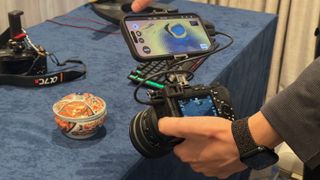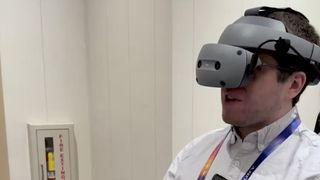- Sony's new XR headset is all about creating content
- The new Xyn sub-brand covers 3D scanning and creation
- It's similar to other headsets, with one major design difference
Even without unveiling its next-generation Bravia TV lineup, Sony still has a pretty packed CES 2025. Case in point is Xyn, a new sub-brand within Sony focused on capturing, creating, and playing within spatial worlds, and I got to go hands-on with the Xyn Headset Prototype as well as a new solution for capturing in 3D.
The entire lineup is about spatial creation, so unlike PlayStation VR 2 or Meta Quest 3 or 3S, Xyn’s Headset is all about people and brands – big or small – who want to create content.
The Xyn Headset is pretty lightweight and takes a familiar form; I was right at home demoing the prototype, which easily rested on my head and, like countless other headsets, could be tightened or loosened via a dial at the back. The real stars here are the fact that it can be self-powered (meaning it doesn’t need to be plugged into any other device) and the 4K screens.
@techradar ♬ original sound - TechRadarIn my hands-on, which you can see a video of below, I was viewing a digital environment on 4K micro-OLED displays – one for each eye. The space around me consisted of some ground, various building elements, and even skeletons. The main event, so to speak, was a bunch of crystal rock formations of varying shapes and designs; I was tasked with placing them in and around the environment.
And these elements weren’t just drawn up in a creative app, but rather scanned in using another piece of the Xyn portfolio. With the controller in hand, I could resize the crystals and place them anywhere, all fairly easily. It all felt pretty fluid even for an early prototype. While the graphics were good, the real difference here is that the screen can easily flip up, putting you back in the real world.
Considering these elements were scanned in using a station with a traditional Sony Alpha camera that had a phone running a prototype Xyn app connected to it, it makes the case that a flippable screen to potentially see the items you’re creating 3D images of can be pretty handy.
And that process of scanning items, be it crystals, shoes, or even fancy china, was pretty simple. I watched as a Sony rep snapped several photos of the object and saw the app on the phone show a heat map that glowed blue in the area that was captured.

From there, it gets processed in the cloud, and I could view those 3D models back on a custom glasses-free 3D monitor that has a camera for eye tracking to make the effect really pop. I could see this being handy for folks who want to get started with 3D production, building or creating these elements for virtual world, and even for larger productions.
What’s really neat is the accessibility, because you don’t need a degree in 3D modeling or design, as the app makes the experience quite seamless… at least in this early stage.

We’re covering all of the latest CES news from the show as it happens. Stick with us for the big stories on everything from 8K TVs and foldable displays to new phones, laptops, smart home gadgets, and the latest in AI.
And don’t forget to follow us on TikTok for the latest from the CES show floor!
It could potentially help to open up creating spatial content to more folks, so while the Xyn Headset itself is still a prototype and might not be sold directly to consumers for content consumption, the worlds, objects, and environments potentially created with Xyn Capture and tweaked to perfection on the headset could be seen on more mainstream VR platforms in the future.










 English (US) ·
English (US) ·